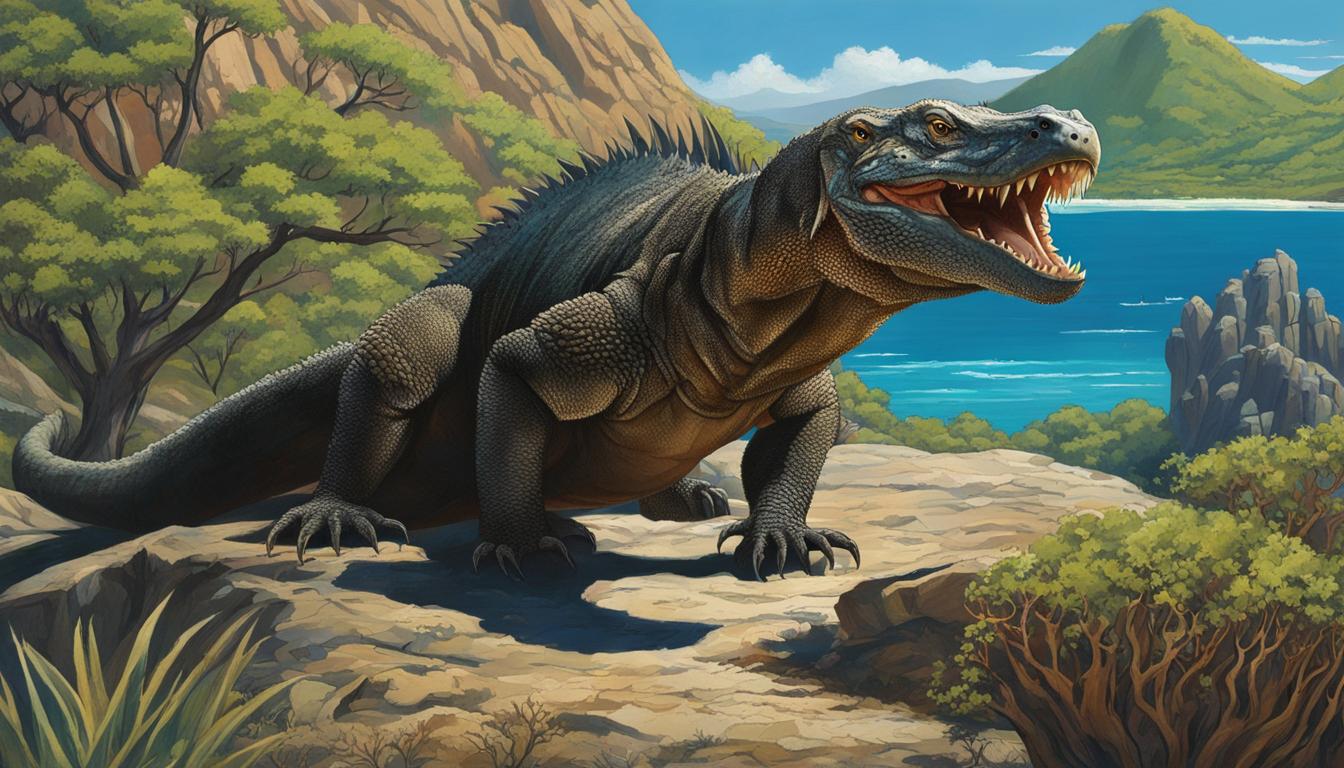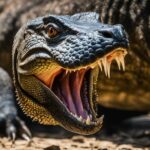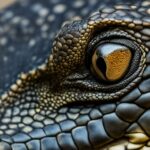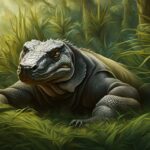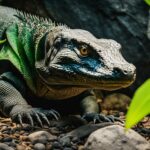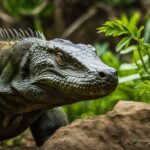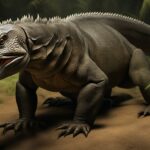Welcome to the captivating realm of Komodo dragon predators, where immense power and cunning hunting tactics reign supreme. These formidable creatures, found in the wilds of Indonesia, hold the title of the largest living lizards on earth. With an impressive length of up to 10 feet and weighing over 300 pounds, they are truly a force to be reckoned with.
Equipped with a venomous bite that can immobilize their prey, Komodo dragons showcase an unparalleled prowess in the art of hunting. In this enthralling journey, we will delve into their hunting behavior, unique adaptations, and their place as apex predators in their ecosystem.
So, join us as we explore the intriguing world of Komodo dragon predators, their diet, hunting techniques, and the challenges they face. Let’s embark on this adventure together and uncover the secrets that make these creatures a true marvel of the natural world.
The Komodo Dragon’s Diet and Prey
The Komodo dragon, being an apex predator, has a diverse diet that changes as it grows. In its early stages, the dragon feeds on small reptiles, birds, and insects. As it grows larger and more formidable, it starts hunting bigger game, such as deer, horses, and water buffaloes. Due to its massive size, the Komodo dragon needs to consume a substantial amount of food to sustain itself. This often leads to an interesting phenomenon in its island habitat, where food can be scarce. Younger dragons, in an attempt to avoid being eaten by their larger counterparts, will climb up trees, demonstrating their unique survival instincts.
To showcase the different stages of the Komodo dragon’s diet and prey, a comparative table can be used:
| Stage | Diet |
|---|---|
| Young Komodo Dragon | Small reptiles, birds, insects |
| Adult Komodo Dragon | Deer, horses, water buffaloes |
| Scarce Food Situation | Cannibalism, with younger dragons climbing trees to avoid larger counterparts |
As shown in the table, the Komodo dragon’s diet evolves as it matures, adapting to the availability of prey in its environment. This ability to adapt makes it a successful predator in its ecosystem.
Komodo Dragon’s Hunting Behavior and Tactics
The hunting behavior of Komodo dragons is a fascinating display of stealth and precision. These apex predators have developed unique tactics to secure their prey, showcasing their adaptability and prowess in the wild. Let’s explore the hunting patterns and strategies employed by these remarkable creatures.
Hunting Techniques
- Ambush Predators: Komodo dragons are ambush predators, patiently waiting for unsuspecting prey to come within striking distance. They blend seamlessly into their surroundings, camouflaging themselves with their natural environment. This allows them to remain undetected and increase their chances of success during the hunt.
- Opportunistic Feeding: Komodo dragons are opportunistic feeders, taking advantage of various food sources they encounter. From small reptiles and birds to large mammals like deer and water buffaloes, they can adjust their hunting strategies based on the availability of prey in their habitat.
- Group Hunting: While Komodo dragons are typically solitary animals, they have been observed engaging in group hunting behaviors. By working together, they can bring down larger prey and increase their chances of a successful kill. This cooperative hunting strategy demonstrates their intelligence and social dynamics.
Venomous Bite and Hunting Success
One of the most remarkable aspects of Komodo dragon hunting is their venomous bite. The saliva of these reptiles contains a potent blend of toxins, including bacteria that cause septicemia, resulting in rapid deterioration of the prey’s health. When a Komodo dragon bites its victim, the venom quickly takes effect, weakening and eventually incapacitating the prey.
This hunting tactic allows the Komodo dragon to take down animals much larger than itself. Even after the initial attack, the dragon carefully tracks the wounded prey, patiently waiting for it to succumb to its injuries. This method ensures a successful kill and a readily available food source for the predator.
Table: Hunting Behavior Comparison
| Tactic | Komodo Dragon | Other Predators |
|---|---|---|
| Ambush Hunting | ✔ | ✔ |
| Opportunistic Feeding | ✔ | ✔ |
| Group Hunting | ✔ | ✖ |
| Venomous Bite | ✔ | ✖ |
“The hunting behavior of Komodo dragons is a testament to their evolutionary success in the wild. From their ability to patiently wait in ambush to their venomous bite, these formidable predators have honed their hunting techniques over thousands of years.”
Understanding the hunting behavior and tactics of Komodo dragons provides valuable insights into their role as apex predators and their unique place in the natural world. By delving deeper into their hunting patterns and strategies, we can better appreciate the complexity and beauty of these magnificent creatures.
Komodo Dragon Predators in the Ecosystem
As an apex predator, the Komodo dragon has few natural enemies. However, it may face predation from other large predators in its ecosystem, such as crocodiles. These powerful reptiles pose a threat to Komodo dragons, especially when they venture into areas with water sources, where crocodiles are known to ambush their unsuspecting prey. While the Komodo dragon is a formidable predator in its own right, it must exercise caution and be vigilant against potential attacks from these natural enemies.
Aside from crocodiles, Komodo dragons may also fall victim to other predators during certain stages of their life cycle. Young Komodo dragons, in particular, are vulnerable to predation by birds and other reptiles. These smaller predators may see young Komodo dragons as easy targets, taking advantage of their smaller size and relative inexperience. However, as Komodo dragons grow larger, they become less susceptible to predation and can defend themselves against potential threats.
Predation on Komodo Dragons
Predation on Komodo dragons by other animals is not a common occurrence. However, there have been reported cases of cannibalism among Komodo dragons, where larger individuals prey on smaller ones. This can happen when food is scarce, and competition for resources is high. Younger Komodo dragons may climb up trees to avoid being eaten by larger individuals, showcasing their ability to adapt and survive even in challenging situations. These instances of intraspecific predation provide insights into the complex dynamics of the Komodo dragon’s ecosystem.
| Predators of the Komodo Dragon | Predation Frequency |
|---|---|
| Crocodiles | Occasional |
| Birds and other reptiles | Vulnerable during early life stages |
| Cannibalism | Occurs during periods of scarcity |
Overall, while the Komodo dragon may face some predation risks from other predators, it remains a dominant force within its ecosystem. Its size, strength, and venomous bite make it a formidable predator that is not commonly preyed upon. Yet, the intricate web of interactions between the Komodo dragon and its natural enemies adds to the biodiversity and ecological balance of its habitat.
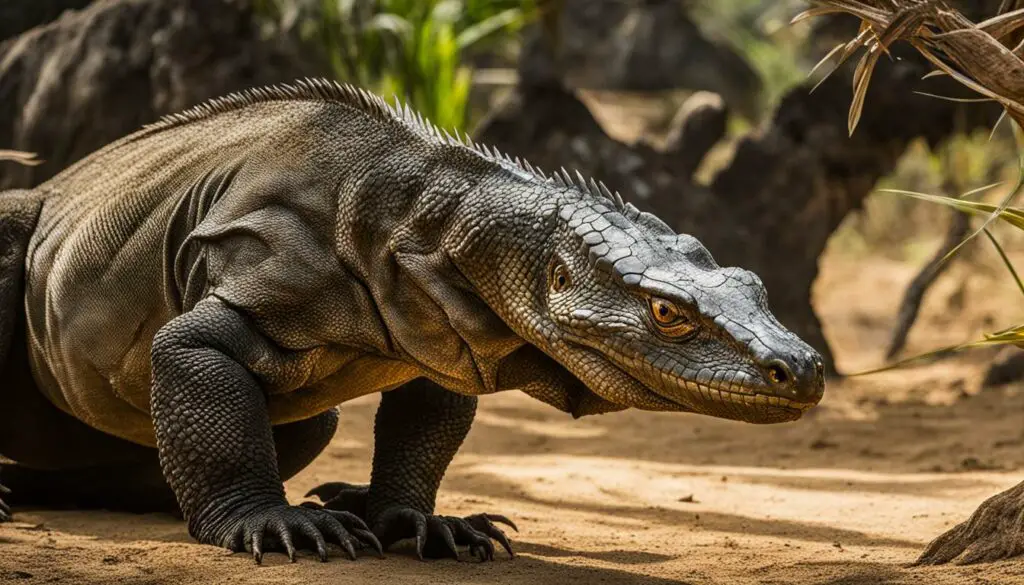
Threats to the Komodo Dragon and Conservation Efforts
The Komodo dragon, a majestic apex predator, is facing numerous threats to its survival in the wild. Habitat destruction, primarily due to human activities such as deforestation and urbanization, poses a significant risk to the Komodo dragon’s habitat. This destruction not only affects the available space for the dragons to live but also impacts their prey populations, creating a ripple effect throughout the ecosystem.
Climate change is another pressing concern for the Komodo dragon. Rising temperatures and changing weather patterns can disrupt the delicate balance of their ecosystem, affecting the availability of food and suitable habitats. As sea levels continue to rise, coastal areas where the dragons reside may become submerged, further reducing their habitat and food sources.
Illegal poaching and hunting also threaten the Komodo dragon population. These magnificent creatures are highly sought after in the illegal wildlife trade due to their unique characteristics and status as a protected species. Poaching not only depletes the population but also disrupts the natural balance of their ecosystem. To combat these threats and protect the Komodo dragon, conservation efforts are being implemented.
Conservation Efforts for Komodo Dragons
Efforts to conserve the Komodo dragon are focused on multiple fronts, including research, education, and the establishment of protected areas. Conservation organizations and government agencies are working together to raise awareness about the importance of preserving these unique reptiles and their habitats.
- Research: Scientists are conducting studies to better understand the biology, behavior, and habitat requirements of Komodo dragons. This research helps inform conservation strategies and management plans for their protection.
- Education: Public awareness campaigns and educational programs are being conducted to promote the conservation of Komodo dragons. These initiatives aim to engage local communities, tourists, and policymakers in understanding the value of preserving these iconic creatures and their habitats.
- Protected Areas: The establishment of protected areas, such as the Komodo National Park, plays a crucial role in safeguarding the Komodo dragon population. These protected areas provide a sanctuary for the dragons and their prey, ensuring their long-term survival.
Anti-poaching laws and enforcement efforts have also been implemented to combat illegal hunting and trading of the Komodo dragon. These measures aim to deter poachers and protect the species from further exploitation.
While the threats to the Komodo dragon are significant, concerted conservation efforts give hope for their future. By raising awareness, conducting research, and implementing protective measures, we can ensure that these magnificent creatures continue to roam our planet for generations to come.
Komodo Dragon Habitat and Distribution
The Komodo dragon, also known as Varanus komodoensis, is endemic to the Indonesian islands of Komodo, Rinca, Flores, and Gili Motang. These islands collectively form the Komodo National Park, which is their primary habitat and a designated protected area. Komodo dragons thrive in a variety of ecosystems, including dry grasslands, savannas, and tropical forests at low elevations.
Climate change poses a significant threat to the habitat of Komodo dragons. Rising temperatures and sea levels are predicted to shrink their available habitat in the coming years, disrupting the delicate balance of their ecosystem. Conservation efforts are crucial to preserving their habitat and ensuring their continued survival.
Unique Habitat Requirements
While Komodo dragons are adaptable to different habitats, they have specific requirements for their survival. They need access to both fresh water and saltwater sources, as they can swim between islands in search of food and mates. Their habitat must provide a sufficient food supply, which includes a variety of prey species, such as deer, wild boar, and smaller reptiles. These factors, combined with the need for suitable nesting sites and protection from potential predators, shape the distribution of Komodo dragons in their native range.
Distribution and Conservation Status
The distribution of Komodo dragons is limited to the Indonesian islands mentioned earlier. The population size is estimated to be around 3,000 individuals, with less than 1,400 adults remaining in the wild. Due to habitat destruction, climate change, and poaching, the Komodo dragon is listed as an endangered species. Conservation efforts, such as the establishment of protected areas and anti-poaching measures, aim to safeguard their population and preserve their unique habitat.
| Island | Area | Population |
|---|---|---|
| Komodo | 390 square kilometers | Approximately 1,700 individuals |
| Rinca | 198 square kilometers | Approximately 1,300 individuals |
| Flores | 5,165 square kilometers | Approximately 1,000 individuals |
| Gili Motang | 30 square kilometers | Approximately 60 individuals |
Characteristics and Adaptations of Komodo Dragons
The Komodo dragon, the largest living lizard, possesses several unique characteristics and adaptations that contribute to its success as an apex predator in its ecosystem. These features enable the Komodo dragon to survive and thrive in its natural habitat.
Physical Characteristics
The Komodo dragon has a long, flat head with a rounded snout, giving it a distinct appearance. Its scaly skin is reinforced with armoured scales containing tiny bones called osteoderms, providing natural protection against potential threats. This combination of features makes the Komodo dragon a formidable creature.
Additionally, the Komodo dragon has bowed legs and a muscular tail, which aid in its agility and agility. These physical attributes allow the Komodo dragon to move swiftly and maneuver efficiently, whether in pursuit of prey or during territorial disputes with other individuals.
Adaptive Techniques
One of the most remarkable adaptations of the Komodo dragon is its venomous bite. Although primarily a result of bacteria residing in its saliva, the venom lowers blood pressure, prevents blood clotting, and causes blood loss and shock in the prey. This venomous bite enhances the Komodo dragon’s hunting success, as the incapacitated prey is easier to subdue and devour.
Furthermore, the Komodo dragon possesses a keen sense of smell, using its tongue to detect, taste, and smell stimuli in its environment. This adaptive technique aids the dragon in locating prey from considerable distances, allowing for strategic hunting behavior and survival.
The Table below highlights the characteristics and adaptations of Komodo dragons:
| Characteristic/Adaptation | Description |
|---|---|
| Size and Strength | The Komodo dragon is the largest living lizard, reaching up to 10 feet in length and weighing over 300 pounds. Its size and strength give it a significant advantage in overpowering prey and defending its territory. |
| Venomous Bite | The Komodo dragon’s bite delivers a venom that lowers blood pressure, prevents blood clotting, and causes blood loss and shock in the prey. This venomous bite aids in capturing and immobilizing prey. |
| Armoured Scales | The scaly skin of the Komodo dragon is reinforced with armoured scales containing tiny bones called osteoderms. This natural protection helps defend against potential threats and reduces vulnerability. |
| Keen Sense of Smell | The Komodo dragon has a highly developed sense of smell and relies on its tongue to detect, taste, and smell stimuli in its environment. This adaptation is crucial for locating prey and navigating its surroundings. |
The unique characteristics and adaptations of the Komodo dragon contribute to its impressive hunting prowess and survival in its habitat. These remarkable reptiles are a testament to the diversity and complexity of the natural world.
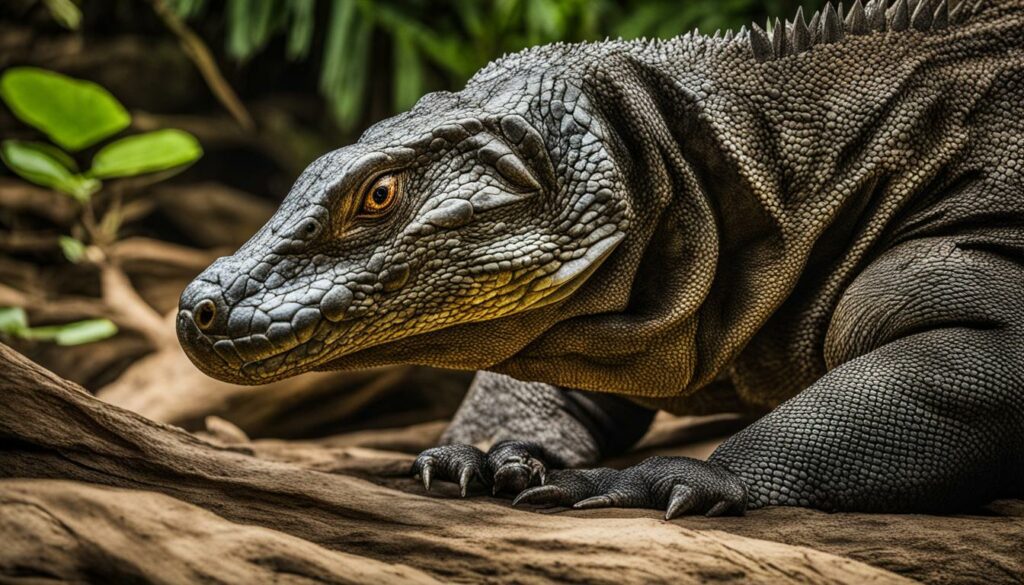
Reproduction and Life Cycle of Komodo Dragons
The reproduction and life cycle of Komodo dragons are fascinating processes that contribute to the survival and growth of this remarkable species. Understanding their reproductive behavior and the various stages they go through can provide valuable insights into their biology and conservation needs.
During the mating season, which typically occurs between May and August, male Komodo dragons actively compete for the attention of females. Dominant males engage in fierce battles, using their powerful tails and sharp claws to establish dominance. Once a male successfully mates with a female, she will lay a clutch of approximately 30 eggs in a secluded nest. These eggs are carefully guarded and incubated for a period of seven to eight months.
As the eggs near the end of their incubation period, the baby Komodo dragons, known as hatchlings, begin to emerge. They are relatively vulnerable at this stage and face potential threats from predators, including larger Komodo dragons. To protect themselves, hatchlings often seek refuge in trees, where they can avoid being hunted and establish their own territories.
It takes several years for Komodo dragons to reach maturity, with males typically reaching sexual maturity around the age of 8 to 9 years. Once they are mature, Komodo dragons engage in the reproductive cycle themselves, perpetuating the population. Despite their impressive size and strength, Komodo dragons have an average lifespan of up to 30 years, emphasizing the importance of protecting their habitat and ensuring their long-term survival.
Komodo Dragon Life Cycle
| Stage | Description |
|---|---|
| Egg Laying | Females lay approximately 30 eggs in a secluded nest and guard them during the incubation period. |
| Incubation | The eggs are carefully incubated for seven to eight months until the hatchlings begin to emerge. |
| Hatchlings | Young Komodo dragons, known as hatchlings, face potential threats from predators and often seek refuge in trees. |
| Maturity | It takes 8 to 9 years for Komodo dragons to reach sexual maturity and contribute to the reproductive cycle. |
| Lifespan | Komodo dragons have an average lifespan of up to 30 years. |
The life cycle of Komodo dragons is a delicate and intricate process that requires conservation efforts to protect their habitat and ensure their continued existence in the wild. By understanding and appreciating their reproductive behavior, we can contribute to the preservation of these magnificent creatures for generations to come.
Human Interactions and Impact on Komodo Dragons
Human activities have had both positive and negative impacts on the Komodo dragon population. While humans have played a crucial role in conservation efforts, they have also posed significant threats to the survival of these iconic creatures. The interaction between humans and Komodo dragons has shaped their habitat, food sources, and overall well-being.
One of the main threats to Komodo dragons is habitat destruction. As human populations expand and develop the land, the natural habitats of these lizards are being destroyed. Deforestation, urbanization, and agricultural activities have led to the loss of crucial habitats, forcing Komodo dragons to adapt to new environments that may not provide adequate resources for their survival.
Poaching is another major concern for Komodo dragons. The decline of their primary food source, the Timor deer, can be attributed to illegal hunting practices. Overhunting disrupts the delicate balance of the ecosystem and deprives Komodo dragons of their natural prey, leading to malnutrition and population decline.
Furthermore, human activities such as tourism can have both positive and negative impacts on Komodo dragons. While tourism can contribute to the local economy and support conservation efforts, it can also disrupt the natural behavior of these lizards. Feeding or interacting with Komodo dragons in an unnatural way can alter their feeding patterns and diminish their survival skills. It is important for tourists and visitors to respect the natural habitat and behavior of Komodo dragons to ensure their long-term well-being.
In conclusion, human interactions have had a significant impact on Komodo dragons. While humans have contributed to their conservation through anti-poaching laws and protected areas, habitat destruction, poaching, and disturbance of natural behavior pose ongoing threats to these magnificent creatures. It is crucial to continue raising awareness, implementing conservation measures, and promoting sustainable practices to protect the future of Komodo dragons and ensure their survival for generations to come.
Conservation Efforts and Future Outlook
Protecting the Komodo dragon and ensuring its long-term survival is a priority for conservation organizations and government agencies. Through collaborative efforts, a range of initiatives has been implemented to address the threats facing these iconic creatures. Research plays a crucial role in understanding the Komodo dragon’s ecology, behavior, and population dynamics. This knowledge informs conservation strategies and helps monitor the effectiveness of implemented measures.
Anti-poaching measures have been put in place to combat illegal hunting and trading of Komodo dragons and their prey. Strict anti-poaching laws and enforcement efforts aim to deter poachers and disrupt the illegal wildlife trade. Education and awareness campaigns are also vital in engaging local communities, raising awareness about the importance of conservation, and promoting sustainable practices.
The establishment of protected areas, such as the Komodo National Park, provides a safe haven for the Komodo dragon and its ecosystem. These protected areas serve as a sanctuary where natural habitats can be preserved and wildlife can thrive. By designating specific regions as protected, governments can regulate human activities within these areas and enforce strict conservation regulations.
| Conservation Efforts | Future Outlook |
|---|---|
| Research and monitoring | Continued habitat destruction |
| Anti-poaching measures | Climate change impacts |
| Education and awareness | Sustainable tourism practices |
| Establishment of protected areas | Collaborative international efforts |
“Conservation is an ongoing effort that requires dedication, collaboration, and adaptive strategies. As we continue to face challenges such as habitat destruction and climate change, it is crucial to remain vigilant in our conservation efforts for the future of Komodo dragons.”
While conservation efforts have made significant progress in protecting the Komodo dragon, the future of these remarkable creatures remains uncertain. Ongoing habitat destruction, driven by human activities, poses a continued threat to their survival. Climate change further compounds these challenges, with rising temperatures and sea levels impacting the Komodo dragon’s habitat.
However, there is hope for the future. Sustainable tourism practices can contribute to the local economy while supporting conservation efforts. By promoting responsible tourism, we can ensure that visitors have a minimal impact on the Komodo dragon’s habitat and raise funds for conservation initiatives. Collaborative international efforts are also essential in creating awareness, sharing knowledge, and fostering cooperation in the conservation of Komodo dragons.
With continued dedication, research, and the implementation of effective conservation strategies, we can work towards securing a future where Komodo dragons thrive in the wild. By protecting their habitats, combating illegal activities, and raising awareness, we can make a positive impact on the conservation of these magnificent predators and preserve their place in the natural world.
Conclusion
The world of Komodo dragon predators is truly awe-inspiring. These remarkable creatures have adapted to their environment by developing unique hunting behaviors and tactics. Their diverse diet, ranging from small reptiles and birds to large animals like deer and water buffaloes, showcases their incredible predatory skills.
Komodo dragons are apex predators, meaning they have few natural enemies. However, they may face predation as eggs and young individuals by birds and other reptiles. Their large size, venomous bite, and excellent camouflage make them formidable predators in their ecosystem.
While the Komodo dragon population is currently endangered, there is hope for their future. Conservation efforts, including anti-poaching laws and the establishment of protected areas like the Komodo National Park, are underway to protect these magnificent creatures and their habitat. By understanding and appreciating the world of Komodo dragon predators, we can contribute to their conservation and ensure a future where they continue to thrive in the wild.
What Makes the Komodo Dragon’s Bite Venomous?
The komodo dragon’s deadly venomous bite is achieved through a unique combination of potent venom and serrated teeth. When the dragon bites its prey, the venom is injected, causing a quick and effective paralysis. This allows the dragon to take down large animals and devour their carcasses at its own leisure.
FAQ
What is the diet of the Komodo dragon?
The Komodo dragon has a diverse diet that changes as it grows. While young, it feeds on small reptiles, birds, and insects. As it grows, it starts hunting larger animals like deer, horses, and water buffaloes.
How do Komodo dragons hunt?
Komodo dragons are ambush predators that rely on their excellent camouflage and patience when hunting. They lie in wait for passing prey and then spring into action, using their sharp claws and serrated teeth to eviscerate their victims. Their venomous bite contributes to their hunting success.
What are the predators of the Komodo dragon?
As an apex predator, the Komodo dragon has few natural enemies. However, it may face predation from other large predators in its ecosystem, such as crocodiles.
What are the threats to the Komodo dragon and what conservation efforts are in place?
The primary threats to the Komodo dragon’s survival are habitat destruction and climate change. Poaching of their primary food source, the Timor deer, has also contributed to their decline. To protect the species, anti-poaching laws have been enacted, and conservation efforts are underway, including research, education, and the establishment of protected areas like the Komodo National Park.
Where do Komodo dragons live?
Komodo dragons are endemic to the Indonesian islands of Komodo, Rinca, Flores, and Gili Motang. These islands, collectively known as the Komodo National Park, are their primary habitat and a designated protected area.
What are the characteristics and adaptations of Komodo dragons?
Komodo dragons have long, flat heads with rounded snouts, scaly skin, bowed legs, and muscular tails. Their skin is reinforced with armoured scales containing tiny bones called osteoderms, providing them with natural protection. They also have a highly efficient venom delivery system and a keen sense of smell.
How do Komodo dragons reproduce and what is their life cycle?
Komodo dragons mate between May and August. Females lay around 30 eggs, which are incubated for seven to eight months and hatch in April. Young Komodo dragons are vulnerable to predation and usually dwell in trees to avoid being eaten by adult dragons. It takes them 8 to 9 years to reach maturity, and they have an average lifespan of up to 30 years.
How do human activities impact Komodo dragons?
Humans pose a threat to Komodo dragons through habitat destruction, poaching, and disturbance of their natural behavior. The decline of their primary food source, the Timor deer, has also been a result of human activities. However, humans also play a crucial role in conservation efforts, with strict anti-poaching laws and initiatives like the Komodo National Park.
What conservation efforts are in place for Komodo dragons and what does the future hold for them?
Conservation organizations and government agencies are actively working to protect the Komodo dragon and its habitat. Efforts include research, anti-poaching measures, education, and community involvement. However, the future of Komodo dragons remains uncertain due to ongoing threats like habitat destruction and climate change. Continued conservation efforts are crucial for their long-term survival.

